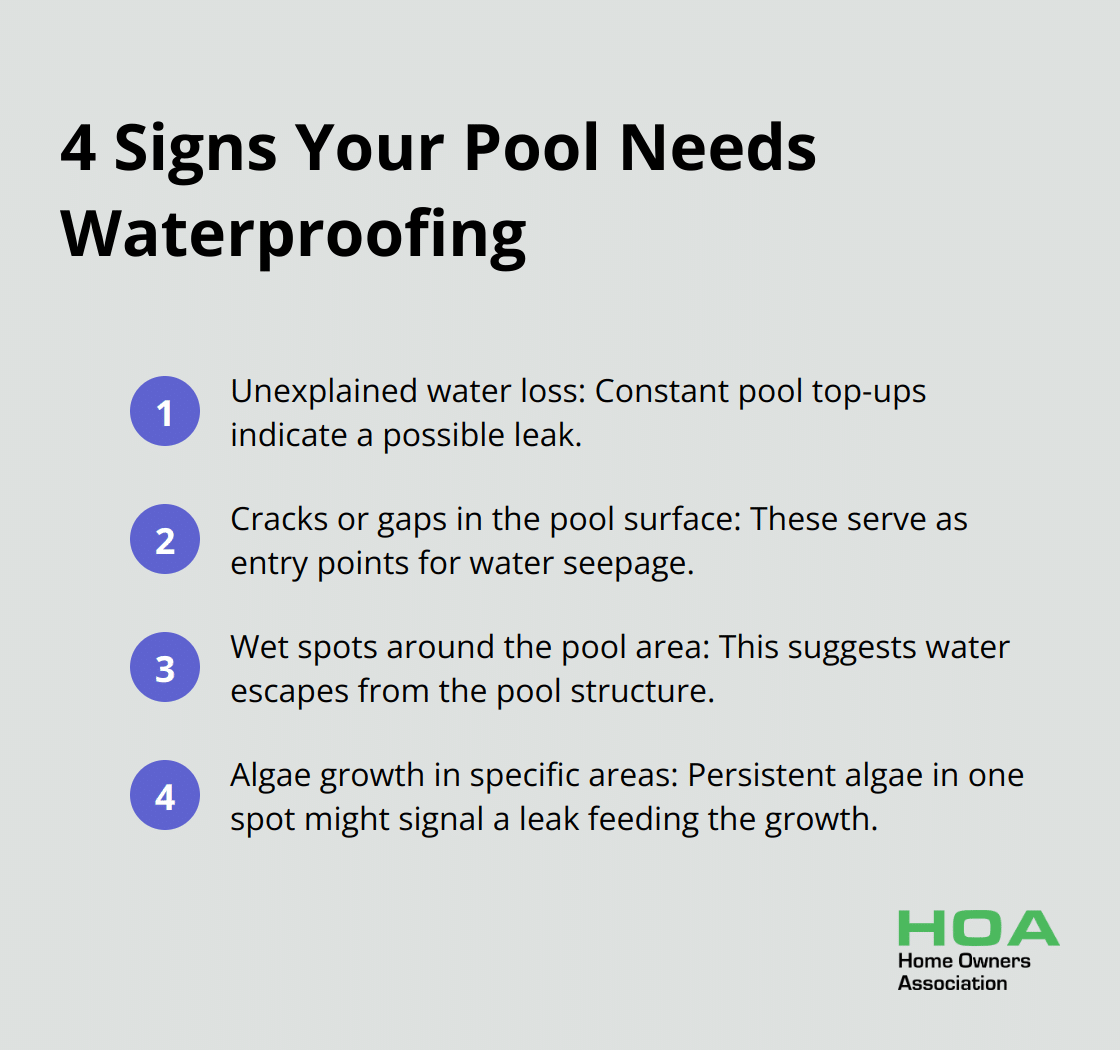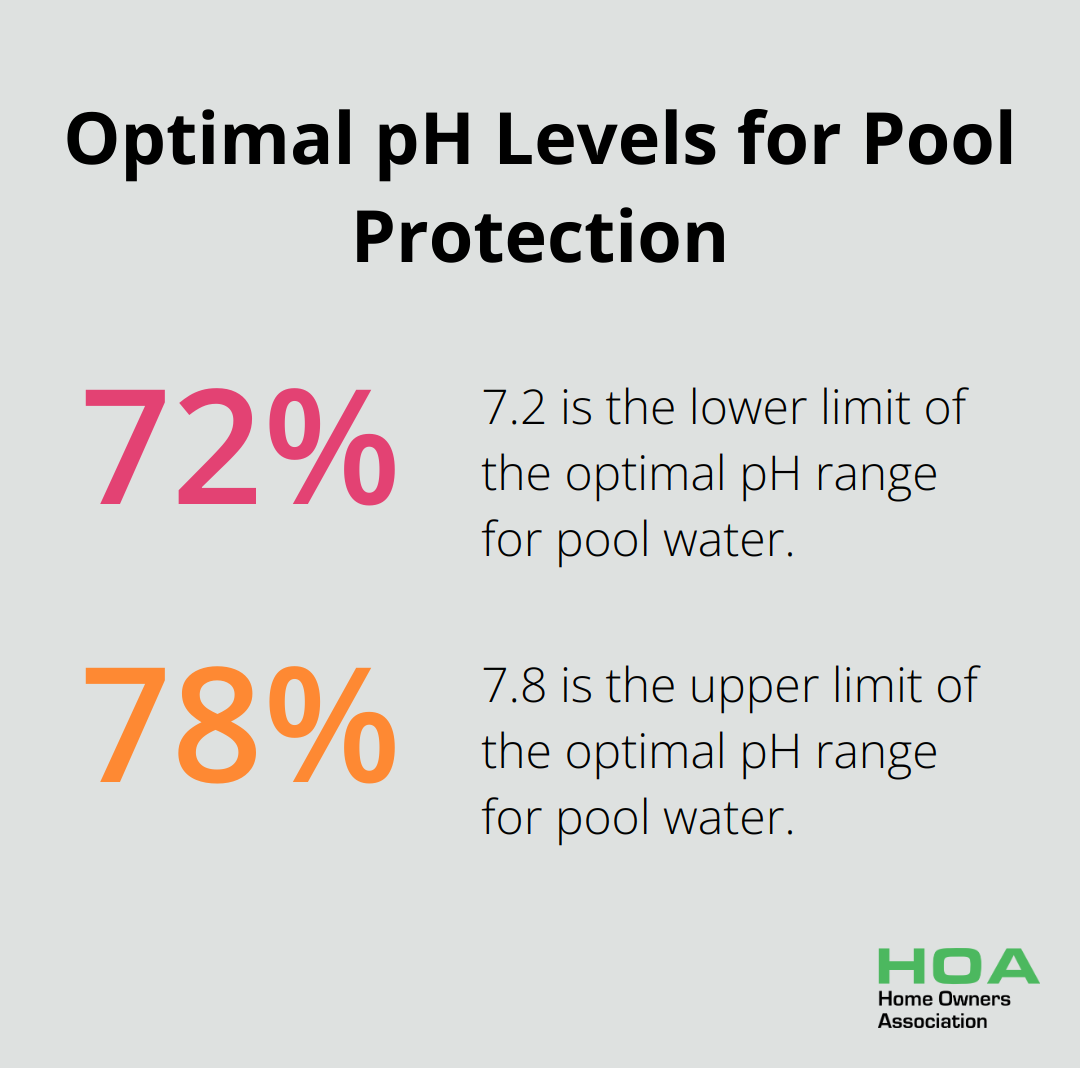
At Home Owners Association, we understand the importance of maintaining a pristine pool for our members. Pool waterproofing is a critical aspect of pool care that often goes overlooked.
A well-waterproofed pool not only prevents leaks but also extends the life of your investment. In this guide, we’ll share essential tips and techniques to keep your pool watertight and worry-free.
Why Pool Waterproofing Matters
The Importance of a Watertight Pool
Pool waterproofing stands as a cornerstone of pool maintenance. This process prevents water from seeping through the pool structure, which can lead to a myriad of problems if not addressed. A properly waterproofed pool saves homeowners thousands of dollars in repairs and extends the life of their investment.
The Hidden Dangers of Pool Leaks
Pool leaks pose more than just a minor inconvenience. They can inflict significant structural damage to your property. Water escaping from your pool erodes the soil underneath and around the pool, potentially causing foundation issues. In extreme cases, this erosion results in pool shell cracks or even collapse.
It’s typical for residential pools without a cover to lose up to a quarter-inch of water per day due to evaporation during the summer. This water loss not only increases utility bills but also puts unnecessary strain on filtration and chemical treatment systems.
Identifying Potential Waterproofing Issues
Early detection of waterproofing problems prevents costly repairs. Look out for these tell-tale signs that your pool needs waterproofing attention:

The Role of Professional Waterproofing
While some minor waterproofing tasks work as DIY projects, professional waterproofing offers several advantages. Experts use specialised equipment to detect even the smallest leaks and have access to industrial-grade waterproofing materials (unavailable to the general public).
Home Owners Association members benefit from our network of vetted professionals who offer discounted rates on waterproofing services. This ensures the job gets done right the first time, potentially saving thousands in future repairs.
The Long-Term Benefits of Proper Waterproofing
Waterproofing a concrete pool prevents hidden damage, saves maintenance costs, and extends your pool’s lifespan. This proactive approach to pool maintenance ensures that your pool remains a source of enjoyment rather than a constant worry.
As we move forward, let’s explore the essential waterproofing techniques that every pool owner should know. These methods will help you maintain a leak-free pool and protect your investment for years to come.
Mastering Pool Waterproofing Techniques
At Home Owners Association, we understand the importance of proper pool waterproofing. Our experience shows that these techniques can save homeowners thousands in repairs and extend pool life by up to 20 years. Let’s explore the most effective methods for ensuring your pool remains watertight.
Waterproof Membrane Application
Applying a waterproof membrane is a critical step in pool protection. The most used swimming pool waterproofing methods include cementitious waterproofing, applying liquid membranes, applying an elastomeric coating, and installing sheet membranes. For optimal results:

- Clean the pool surface thoroughly
- Repair any existing cracks before application
- Apply the membrane in two coats (each at least 25 mils thick when wet)
- Allow the first coat to dry for a minimum of one hour before applying the second
This method typically costs between $10 to $20 per square foot but can vary based on pool size and condition.
Epoxy-Based Sealants for Added Protection
Epoxy-based sealants offer excellent adhesion and chemical resistance, making them ideal for pool waterproofing. Epoxy waterproofing is durable, highly resistant to wear and tear, cost-effective, water and chemical resistant, and requires less maintenance compared to other sealants. To apply:
- Prepare the surface thoroughly
- Apply the epoxy in thin, even layers
- Ensure full coverage of the pool surface
- Allow 24 to 48 hours for curing (always follow manufacturer guidelines)
While more expensive than some alternatives (costing around $30 to $50 per square foot), epoxy sealants can last up to 10 years with proper maintenance.
Pool Liner Installation
Installing a pool liner is an effective waterproofing solution, especially for older pools. Vinyl liners create a watertight barrier and can hide minor imperfections in the pool structure. To install:
- Measure your pool carefully before ordering a liner
- Ensure a perfect fit (professional installation is recommended)
- Allow 1-2 days for installation
Liners cost between $2,000 to $5,000 on average but can last 5-10 years with proper care and significantly reduce water loss.
Choosing the Right Waterproofing Method
When selecting a waterproofing method, consider factors such as pool type, climate, and budget. Regular inspections and prompt repairs of any damage will maximise the effectiveness of these techniques.
The Role of Professional Waterproofing
While some minor waterproofing tasks can be DIY projects, professional waterproofing offers several advantages:
- Experts use specialised equipment to detect even the smallest leaks
- Access to industrial-grade waterproofing materials (often unavailable to the general public)
- Expertise in applying complex waterproofing techniques
Home Owners Association members benefit from our network of vetted professionals who offer discounted rates on waterproofing services. This ensures the job gets done right the first time, potentially saving thousands in future repairs.
Now that we’ve covered the essential waterproofing techniques, let’s move on to maintaining your newly waterproofed pool. Proper maintenance is key to extending the life of your waterproofing efforts and ensuring your pool remains a source of enjoyment for years to come.
How to Keep Your Waterproofed Pool in Top Shape
Regular Inspections: Your First Line of Defence
Regular visual inspections of your pool’s surface are crucial. Pay close attention to areas around fittings, lights, and steps. Look for signs of wear, discolouration, or small cracks. Early detection prevents minor issues from becoming major problems. One of the most significant benefits of weekly pool cleaning is the ability to identify and address minor issues before they escalate into costly repairs.
The Importance of Water Chemistry
Maintain proper chemical balance to preserve your pool’s waterproofing. Test your pool water at least twice a week during peak season. Adjust your pH levels to fall between 7.2 and 7.8, which is optimal for protecting both your pool and surrounding materials. Imbalanced water can erode waterproofing materials, potentially leading to leaks.

Address Issues Promptly
Act quickly when you spot a problem. Repair small cracks or chips in the pool surface within 48 hours to prevent water infiltration. For concrete pools, use hydraulic cement for quick fixes. Patch vinyl liner tears with a vinyl repair kit. Swift action prevents water from compromising the structural integrity of your pool.
The Value of Expert Servicing
Schedule a comprehensive inspection by a certified pool technician at least once a year. These experts can spot issues that might escape the untrained eye and provide specialised treatments to extend the life of your waterproofing.
Cost-Effective Maintenance Strategies
Implement cost-effective strategies to maintain your waterproofed pool. Use a pool cover to reduce debris accumulation and chemical evaporation. Clean your pool filter regularly. Consider using a robotic cleaner to relieve the burden on your filtration system while effectively picking up fine debris and bacteria.
Final Thoughts
Pool waterproofing protects your investment and extends its lifespan. Proper techniques and regular maintenance prevent leaks, structural damage, and water quality issues. A well-maintained, waterproof pool can last up to 30 years, saving you money on repairs and replacements.
Ongoing care preserves the integrity of your pool’s waterproofing. Regular inspections, chemical balance management, and prompt repairs prevent small issues from becoming major problems. Consistent maintenance routines ensure your pool remains a source of enjoyment for years to come.
Home Owners Association helps Melbourne homeowners maintain their pools effectively. Our network of professionals and member discounts make pool waterproofing more accessible (and affordable). You can keep your pool in top condition while enjoying savings on materials and services.





